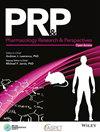联合使用氟康唑可提高西罗莫司的治疗浓度:病例报告
IF 2.9
4区 医学
Q2 PHARMACOLOGY & PHARMACY
引用次数: 0
摘要
西罗莫司的个体全血浓度变化很大,主要受同时使用细胞色素 P450 (CYP) 3A 诱导剂或抑制剂的影响,还受食物的调节。因此,建议进行治疗药物监测,尤其是在治疗开始时或可能影响西罗莫司暴露的情况下。在本病例报告中,我们强调了达到西罗莫司治疗浓度所面临的挑战,并提出了务实的解决方案,包括调整治疗方案、药代动力学增强(使用药物间相互作用)、浓度监测以及随后的群体药代动力学建模,以支持治疗决策。在一名接受异体造血干细胞移植的 69 岁女性患者身上,他克莫司的浓度一直保持稳定,直到她患上脑弓形虫病并伴有强直阵挛发作。在治疗这种急性感染期间,他克莫司的浓度降至治疗水平以下,并且基本上不受剂量增加的影响。只有同时使用 CYP3A4 抑制剂氟康唑,并将西罗莫司的给药间隔缩短为(未获批准的)每天两次,才能成功控制其浓度,最终甚至有可能减少剂量。这一干预措施将西罗莫司的平均谷浓度提高到了 5.85 纳克/毫升,即达到了预期的目标范围。此外,开始使用氟康唑后,西罗莫司谷浓度/每日剂量的比率从 26.9 增至 109 纳克/毫升/毫克/千克/天。因此,本病例报告描述了如何利用临床药理学概念和药代动力学模型来优化个体患者的治疗策略。这种策略可以推广到其他 CYP 抑制剂和其他治疗方案中。本文章由计算机程序翻译,如有差异,请以英文原文为准。
Coadministration of fluconazole to boost subtherapeutic sirolimus concentrations: A case report
Individual sirolimus whole blood concentrations are highly variable, critically influenced by the concomitant use of cytochrome P450 (CYP) 3A inducers or inhibitors, and also modulated by food. Therapeutic drug monitoring is therefore recommended, especially at treatment start or in circumstances that can influence sirolimus exposure. In this case report, we highlight the challenge of achieving therapeutic sirolimus concentrations and present pragmatic solutions with regimen adaptions, pharmacokinetic enhancement (use of a drug–drug interaction), concentration monitoring, and subsequent modeling of population pharmacokinetics to support treatment decisions. In a 69‐year‐old female patient with allogeneic hematopoietic stem cell transplantation, tacrolimus concentrations were stable until she developed cerebral toxoplasmosis with tonic–clonic seizures. During treatment of this acute infection, tacrolimus concentrations dropped to subtherapeutic levels and remained largely unaffected by dose increases. Only the simultaneous administration of the CYP3A4 inhibitor fluconazole and a shortening of the sirolimus dosing intervals to a (non‐approved) twice‐daily administration led to successful control of the concentrations, which ultimately even made a dose reduction possible. This intervention resulted in an increase of sirolimus mean trough concentration to 5.85 ng/mL, i.e., into the desired target range. Additionally, a higher ratio of sirolimus trough levels/daily dose from 26.9 to 109 ng/mL/mg/kg/day was achieved with the initiation of fluconazole. Thus, this case report describes the use of clinical pharmacological concepts and pharmacokinetic modeling to optimize treatment strategies in an individual patient. This strategy could be generalized to other CYP inhibitors and other treatment regimens.
求助全文
通过发布文献求助,成功后即可免费获取论文全文。
去求助
来源期刊

Pharmacology Research & Perspectives
Pharmacology, Toxicology and Pharmaceutics-General Pharmacology, Toxicology and Pharmaceutics
CiteScore
5.30
自引率
3.80%
发文量
120
审稿时长
20 weeks
期刊介绍:
PR&P is jointly published by the American Society for Pharmacology and Experimental Therapeutics (ASPET), the British Pharmacological Society (BPS), and Wiley. PR&P is a bi-monthly open access journal that publishes a range of article types, including: target validation (preclinical papers that show a hypothesis is incorrect or papers on drugs that have failed in early clinical development); drug discovery reviews (strategy, hypotheses, and data resulting in a successful therapeutic drug); frontiers in translational medicine (drug and target validation for an unmet therapeutic need); pharmacological hypotheses (reviews that are oriented to inform a novel hypothesis); and replication studies (work that refutes key findings [failed replication] and work that validates key findings). PR&P publishes papers submitted directly to the journal and those referred from the journals of ASPET and the BPS
 求助内容:
求助内容: 应助结果提醒方式:
应助结果提醒方式:


